I came across White River Knife & Tool by accident, really. I received a press release about their company one day in my inbox and was like, “Huh, interesting…” And what I ended up finding on their website was, indeed, interesting.
Before I get into White River the company, allow me to make a general statement about the knife industry, that is thanks to modern technology (CNC machining, 3D printing) it’s now easier to make a knife or edged weapon than it ever was before. Pretty much anyone can make a knife. I guess it’s sorta like the print industry in that way, basically, anyone with a computer can be a “writer.” Likewise, anyone with some simple tools and a little bit of knowhow can purchase a piece of steel, shape it, send it out for heat treating and cryo, sharpen it and throw some slabs of micarta on it and call it a knife. Knife-making isn’t really all that hard, maybe it’s a bit tedious, but, again, anyone can do it.
Obviously, this has an effect on the industry in that it forces serious knifemakers to really distinguish themselves from an increasingly crowded marketplace. Given that everyone has access to the same tools, equipment and steel, an obvious question emerges: what makes your knife better than mine or his or hers, etc?
[one_half]
[/one_half]
[one_half_last]
[/one_half_last]
So, with all the material conditions being pretty much the same across the board, knifemakers are forced to compete in two areas: (a) price and (b) style, but “style” as a product of functionality. In other words, can a knifemaker or manufacturer produce a knife that is both affordable and stylish (without sacrificing utility)? If they can, their chances of success are greatly improved. If they can’t, well, it’ll be tough sledding because there are some serious competitors out there that have perfectly balanced the equation.
Overview
From what I’ve seen, White River Knife & Tool has been successful because they’ve mastered both areas, they make reasonably priced knives that have an attractive and distinguishable artistry. What is their aesthetic? In two words: Naturally elegant. The knife they sent me to review is one of their newer models called the “Sendero Classic,” which was was designed with the help of legendary knife maker Jerry Fisk.
The Sendero Classic is one of their premium knives. It retails around the $250 price point. I think the most expensive, non-custom knife on their website was around $300. The vast majority of their knives are under $200. Yeah, they make knives that won’t break the bank.
The design of the SC is pretty simple, a drop-point blade with a two-piece, full hidden tang handle and a stainless guard. The steel used is CPM S30V, the popular high-carbon, stain-resistant steel made by Crucible Industries. I’m not going to get into the minutia of how CPM S30V compares to other steels, but if you want to geek out of the details here is a pretty good reference. What I will say is that it’s really durable, keeps a wicked edge and is easy to sharpen. And really, for the average consumer, what more could one ask for?
When I received the SC I was duly impressed. It was light, quick in the hand and the blade was razor sharp. I think it was the sharpest knife I’ve ever received from a manufacturer, which says a lot about White River’s attention to detail when they’re putting the finishing touches on one of their blades (I can’t tell you how many times I’ve received dull blades from very popular and successful knife companies).
Specs
Designer: Jerry Fisk
Blade Length: 4.4”
Blade Thickness: .13”
Overall Length: 9.15”
Blade Steel: CPM S30V
Weight: 4.4 oz
Finish: Stone Wash
Hardness: 59 HRC
Handle: Micarta
Sheath: U.S. Made Leather
Price: Around $250
Utility
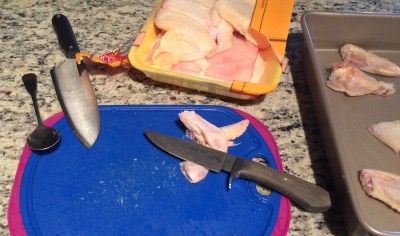
I used the Sendero to process chicken wings, that is, separate the round from the flat. It cut right through the bones, no problem. The other knife pictured is a Ban Tang Santoku.
When I first get a new knife what I like to do is use it in any number of pedestrian kitchen tasks. The theory being, that if the knife doesn’t perform well in cutting up some chicken wings or slicing a tomato or mincing some garlic, chances are it won’t succeed at more demanding jobs. Not only that, there is the question of comfort during use. How comfortable is this knife in the hand during these routine chores?
The SC was great in the kitchen. As I mentioned, the blade was extremely sharp and it cut poultry, steak, bread, fruit, vegetables with no problem. There were no issues after sustained usage. The knife didn’t dull, the blade didn’t stain or rust, there were no chips or rolls, the handle held up well. Outside, when cutting into wood, whittling sticks, and splitting branches (batoning), the knife performed great! While the SC can rock in the kitchen, I get the feeling that she loves to be in the great outdoors.
Arguably the main purpose of the knife is hunting. I’m not a hunter. Well, I should say, I’m working on becoming a hunter. I didn’t get a chance to use the SC to field dress a deer. That would really be the ultimate test for a knife like the SC. What I did instead was use the SC to cut up some old floor mats and rugs. I know, I know, it’s not the best substitute. But hey, I had to get creative! The SC performed great on the rugs and mats. The aggressive handguard (see drawback below) really helped to ensure that my hand didn’t slip down the blade while stabbing through the rug and slicing downward.
[one_half]
[/one_half]
[one_half_last]
[/one_half_last]
Yet, for those of you who are not hunters, the SC also makes an ideal pack knife or camping knife and could serve as a self-defense implement. It’s light, even with the sturdy, leather sheath. It doesn’t weigh your pants down when it’s affixed to a belt. It’s not unwieldy. It’s actually the perfect size and weight for an every day carry (EDC) blade.
Drawbacks
There are two very minor drawbacks to the knife, as far as I can tell. One is the aggressive guard, that really ensures your hand and fingers stay away from the edge. In theory, that’s great. But for those who like to choke up on a knife, or are accustomed to a knife with an accessible choil, this is a bit of an issue. It’s by no means a deal breaker and if you’re used to using knives with guards it won’t be an issue at all but I figured I’d mentioned it. For me, it was a bit awkward at first, but I like to think I adjusted rather nicely to it.
The second drawback is the girth of the handle toward the end of the knife. Like an old-school revolver handle, the knife handle actually gets thicker toward the bottom. I have big hands, so it’s not an issue for me. But ergonomically speaking, one could argue that the knife should be at the very least uniform down the handle or actually thin out because you’re pinky and ring finger are shorter than your index and middle finger.
Again, these are really trivial concerns that say more about me as a user, and my preferences/experiences with other blades than any design flaw with the knife.
Warranty
White River makes no bones about their warranty. They “guarantee every knife for life,” adding that if “you are not 100% satisfied with your White River Knife, return it for repair or replacement, free of charge, no questions asked.” Bottom line: when you buy a White River knife, you buy it for life.
What’s more is that every single component from the steel to the thread in their leather sheaths are sourced and produced in the good old US-of-A. You can’t ask for more than that.
Conclusions
I’m actually really upset, as I’ve agreed to give this knife away. Typically, we can purchase the products we review at a discounted rate, which is awesome. But not this time. I have to part with this baby. The good news is that it will end up in the hands of one of you, a GunsAmerica subscriber.
I’m positive that whoever wins this knife will love it. What’s more, is that I’m definitely going to be a White River customer. I dig everything about them. I love the family-owned aspect, that everything is made in America, their business model, but more than anything else, the quality of their products. The make great stuff! And the Sendero Classic is solidly built, ruggedly stylish and perfect for every fixed-blade EDC task one might have: camping, hunting, fishing, backpacking and, even, self-defense.
To enter the GunsAmerica giveaway to win the Sendero Classic, click here.
To check out White River Knife & Tool, click here.
To view the Sendero Classic directly, click here.


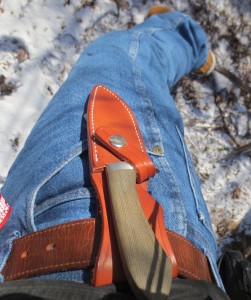
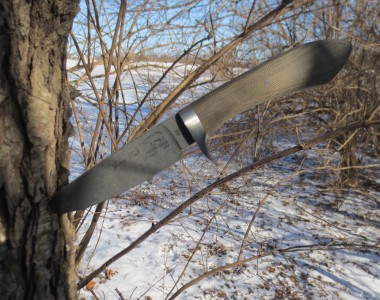
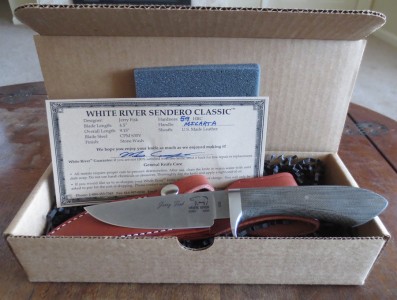
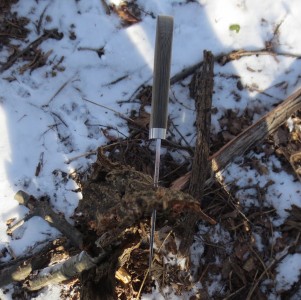
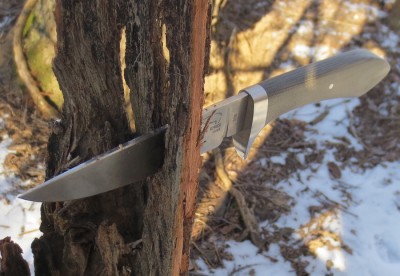
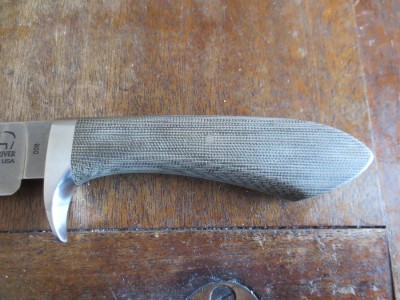
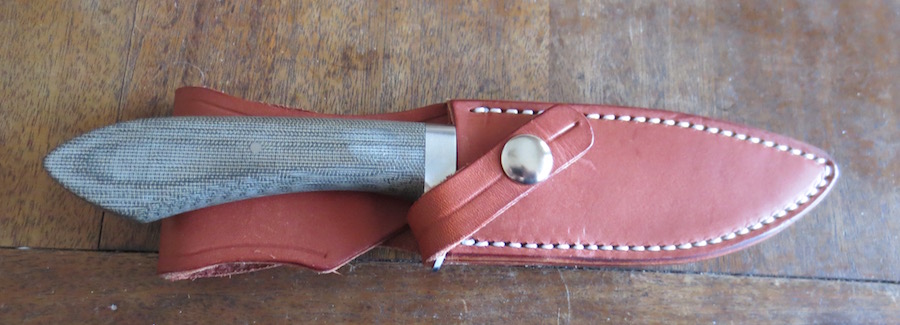
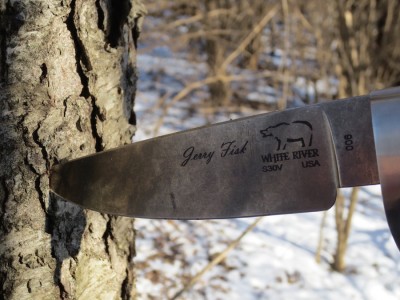
I found another mistake. The knife length is wrong. You need to proof read. Multiple mistakes on key features in one article. I am sorry to say I am not impressed.
What’s the correct length so I can change it?
The knife is not “the perfect pack knife” because it costs $250. Duh
Nice knife. It appears to be a modern rendition of the classic Kephart camp knife. Well done. Very functional.
Please enter me in the White River Knife giveaway. Thank You
I like this type of guard on a hunting knife. You end up dressing a deer by head lamp, it’s raining, you’re tired, in a hurry ’cause bears are in the area, you’re hands a wet, and you’re hours away from the nearest hospital. It’s easy to slip up and slice your index finger. Micarta grip is great for durability (your great-grand kids will be using this knife), but it doesn’t provide an aggressive grip like Krayton, or checkered G10, therefore, guard is called for. I much prefer this type of guard to the current fashion of bump style guards, that are peninsulas jutting from the blade itself (Esee, Buck Reaper), as they are uncomfortable against the index finger. Nice knife.
Looks like a great knife that anyone would find both practical and one they can be proud to own.
I also see another too expensive knife for most, certainly me, when any task I have that can be satisfied by a knife can be handled by one that costs one-fifth of that.
In folding knives I have several commercial knives but in fixed blade knives I stick to proven military ones.
In fixed blade pack knives, I find either my almost fifty year old single edged KBAR or my smaller and almost seventy year old double edged bayonet for my equally old M1 Carbine with original leather sheaths, both of which show little wear, are durable, sharp, tough, solid tang, leather handled knives with a heavy pommel that can take a pounding. I particularly like the muzzle ring on the bayonet which is small enough to act as a hand and thumb protector during hard use. Parkerized, sharp, tough and in two great sizes at least for me and together they cost less than one hundred bucks today. Mine were free but I would gladly pay for them if I had to.
I also have bayonets in different lengths for the M1903 Springfield, M1 Garand and several versions for the M16 of which two are practical for use as fixed blade knives and nearly indestructible. Would I like to own one or more of this or similar really nice commercial or custom knives? Sure. Do I need them enough to justify the cost with other priorities on my list? No. But that’s just me.
Nice looking knife! and I like to find family owned business’s. Now I just need to find out where they are? as I live by the White River in Missouri and Arkansas. I hope its the same White River so I can go to their shop.
ahhh darn…. wrong White River
I also immediately thought the guard was over-sized.
Increasing the handle as this knife does is not only visually pleasing, but it also increases retention should you want to really transmit some force with the knife. As the blade length increases, that swell is one handle shape that will help keep the knife in your hand if you try to chop anything, but even with a knife with a shorter blade like this, the handle shape will help keep the knife in your hand should the blade catch on something as you’re doing a pull cut.. “Thinning out” the handle as you suggest would mean the knife would slip out of your hand easier.
Liked your review, but as an engineer I must correct you on the pretty obvious error of blade thickness, i.e., .31 in your listing of the knife specs. Do you have any idea what what .31 equates to?
That’s 5/16 of an inch, man. That is as thick as a spring leaf on some automobiles. I know that photos can sometimes be misleading, but if the knife you show in your article is 5/16 of an inch thick, then I’m Jim Bowie. Check again; I think you’ll find the blade thickness is more like .19″; that’s 3/16 of an inch, by the way.
Yes, I accidently inverted the 3 and the 1. It’s .13″ — Nice catch!